Laid down 31 October 1981 Length 333 m Launched 27 October 1984 | Ordered 30 September 1980 Commissioned 25 October 1986 Construction started 31 October 1981 | |
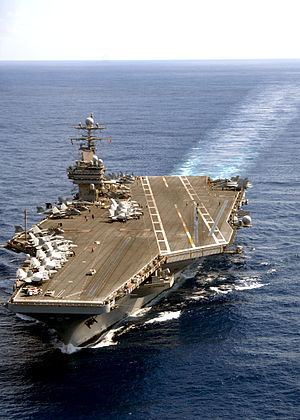 | ||
Cost US $4.5 billion in 2007 dollars. Homeport NAS North Island San Diego, CA | ||
USS Theodore Roosevelt (CVN-71) (also known by crewmembers as "the Big Stick" or within the US Navy simply as TR) is the fourth Nimitz-class aircraft carrier. Her radio call sign is Rough Rider, the name of President Theodore Roosevelt's volunteer cavalry unit during the Spanish–American War. She was launched in 1984, saw her first action during Operation Desert Storm in 1991.
Contents
- Controversies
- Design and construction
- Maiden deployment
- Persian Gulf War
- 19931999
- 2000s
- 2010s
- Ship awards
- References

Controversies
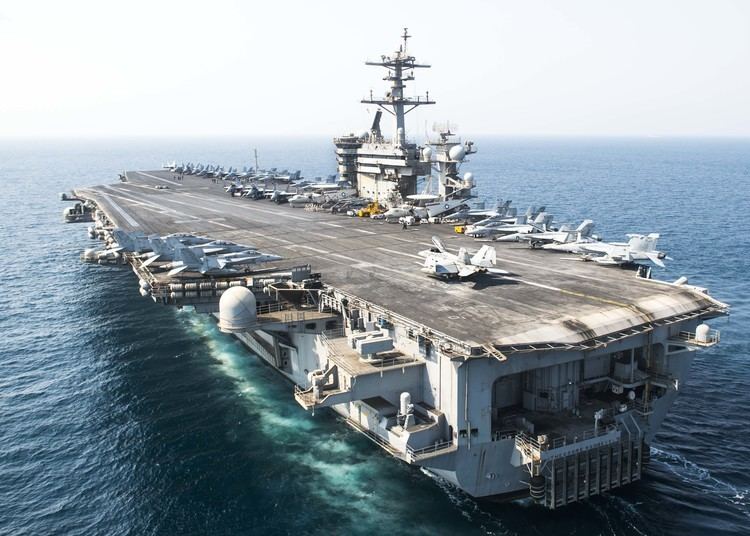
Initially, U.S. President Gerald Ford cancelled the order for CVN-71 in 1976 and substituted two CVV-type medium-sized, conventional-powered carriers that were expected to operate V/STOL aircraft. The existing T-CBL design formed the basis for the new CVV, serving as a replacement for the aging Midway-class aircraft carrier, while capable of operating all existing conventional carrier aircraft. This capability to operate conventional aircraft proved important as the hoped-for supersonic V/STOL fighters did not come to fruition at the time. In any case, construction of the proposed CVV medium-sized carrier never took place.
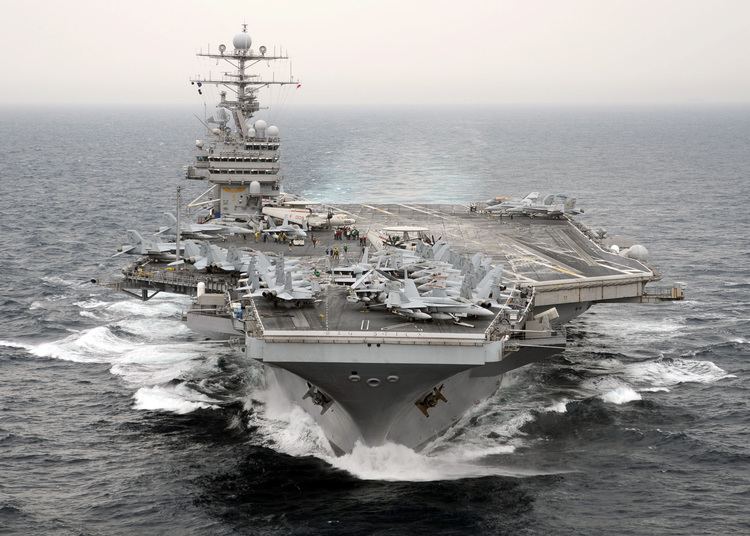
Authorization for CVN-71 was further delayed when President Jimmy Carter vetoed the 1979 Fiscal Year Department of Defense authorization bill because of the inclusion of this Nimitz-class nuclear supercarrier in the U.S. Navy's shipbuilding program. Because of the international crisis that required the increased deployment of U.S. aircraft carrier battle groups to the Indian Ocean, President Carter reversed his stand on Nimitz-class nuclear supercarriers, and CVN-71 was subsequently authorized under the 1980 Fiscal Year authorization bill for the U.S. Department of Defense.
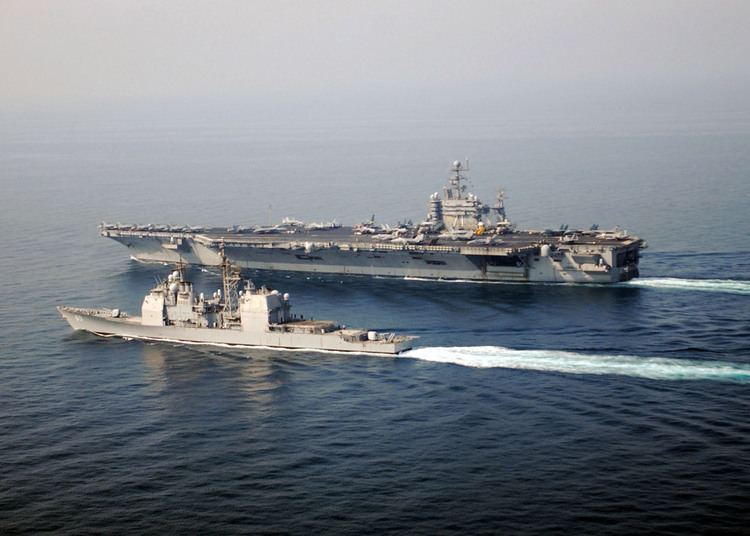
The official ship's daily newspaper is called the "Rough Rider" and is distributed on the ship's mess decks each morning as well as other locations. During the mid-1990s, there existed an underground newspaper called the "Rough Ride" detailing the hardships of the ship's crew and the various unfairness and hardships the crew was experiencing with a humorous and satirical viewpoint. The official paper was replaced by the underground rag, and many people didn't typically realize which version they were reading at first glance. This has been widely covered up and hidden by the ship's command.
Design and construction

Theodore Roosevelt was the first aircraft carrier to be assembled using modular construction, wherein large modules are independently constructed in "lay-down" areas, prior to being hoisted into place and welded together. Modular construction, made possible through the use of a huge gantry crane capable of lifting 900 tons, cut 16 months off Theodore Roosevelt's construction time, and the technique has been used on every aircraft carrier since. Roosevelt and those Nimitz-class vessels completed after her have slight structural differences from the earlier carriers (USS Nimitz, USS Dwight D. Eisenhower, and USS Carl Vinson) and improved protection for ordnance storage in her magazines.
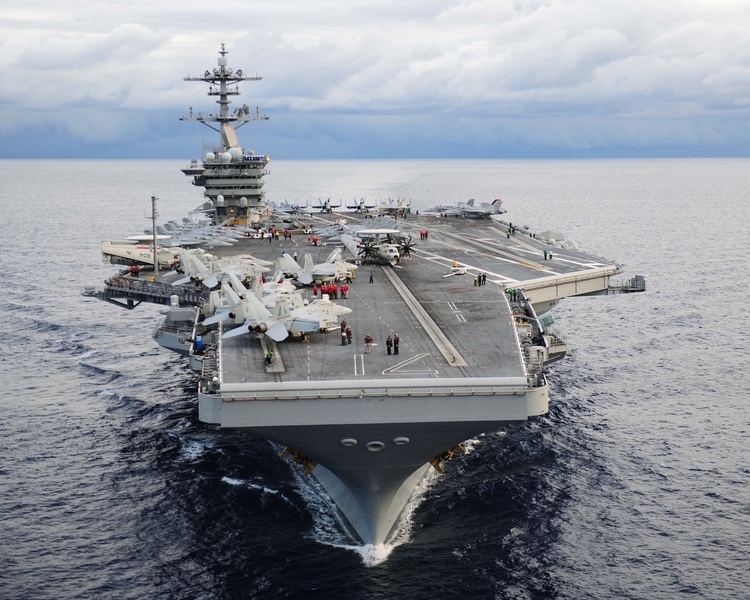
Theodore Roosevelt's history began on 30 September 1980, when a contract was awarded for "Hull 624D" to Newport News Shipbuilding. Her keel was laid down on 31 October 1981, with Secretary of Defense Caspar Weinberger initiating the first weld. On 3 November 1981, Secretary of the Navy John F. Lehman announced that the carrier would be named for the 26th President of the United States, Theodore Roosevelt.
The vessel's Pre-Commissioning Unit (PCU) was formed in February 1984, with Captain Paul W. Parcells named the Commanding Officer. On 27 October 1984, the ship was officially christened by Mrs. Barbara Lehman, wife of Secretary Lehman. On 25 October 1986, Theodore Roosevelt was commissioned to active service at Newport News.
Maiden deployment
After sea trials and pre-deployment workups, Theodore Roosevelt started her maiden deployment on 30 December 1988 with Carrier Air Wing Eight embarked. The ship patrolled the Mediterranean Sea prior to returning on 30 June 1989.
Theodore Roosevelt was awarded the 1989 Battle "E" from Commander, Naval Air Force U.S. Atlantic Fleet on 20 March 1990.
Persian Gulf War
On 28 December 1990, Theodore Roosevelt and CVW-8 deployed for Operation Desert Shield, arriving in the Persian Gulf on 16 January 1991. With the commencement of Operation Desert Storm on 15 January 1991, Theodore Roosevelt began combat operations; eventually flying over 4,200 sorties (more than any other carrier) and dropping more than 4,800,000 pounds (2,177,243.4 kg) of ordnance before the cease-fire on 28 February.
When Iraqi forces turned on the Kurds, Theodore Roosevelt and CVW-8 were among the first coalition forces in Operation Provide Comfort, flying patrols over northern Iraq. After a 189-day deployment, with 176 days at sea, Theodore Roosevelt returned to Norfolk on 28 June 1991. On 14 February 1992, the ship won her second Battle "E". This was followed by the award of the Battenberg Cup for 1991 as the Atlantic Fleet's premier ship.
1993–1999
Theodore Roosevelt began her third deployment on 11 March 1993, again with CVW-8 embarked. Also embarked was a Special Purpose Marine Air-Ground Task Force (SPMAGTF), in a test the concept of embarking a multi-purpose Marine force in a carrier.
While the ship was still in the Virginia Capes operating area, President Bill Clinton flew aboard for several hours for his first visit to a U.S. Navy ship.
Theodore Roosevelt operated in the Adriatic as CVW-8 planes enforced Operation Deny Flight in the U.S. no-fly zone over Bosnia. In June, on the way to only her second port visit, Theodore Roosevelt was ordered instead to transit the Suez Canal en route to the Red Sea to participate in Operation Southern Watch, enforcing the no-fly zone over Iraq.
Deployed for 184 days, Theodore Roosevelt spent 169 days under way prior to return in September 1993. For the accomplishments of her crew, the ship received her second Meritorious Unit Commendation.
From November 1993 to April 1994, Theodore Roosevelt conducted a Selected Restricted Availability (SRA) at Norfolk Naval Shipyard (NNSY), completing ahead of schedule.
On 10 March 1994, Theodore Roosevelt received its third Battle "E". Then on 3 June, Theodore Roosevelt was awarded her second Battenberg Cup as the best ship in the Atlantic Fleet.
Theodore Roosevelt and CVW-8 began their fourth deployment in March 1995, operating in the Red Sea in support of Operation Southern Watch over Iraq, and Operations Deny Flight and Sharp Guard over the skies of Bosnia and in the Adriatic operating areas. Deny Flight evolved into Operation Deliberate Force, as CVW-8 aircraft led NATO strikes against strategic Bosnian Serb targets in Bosnia-Herzegovina. The Theodore Roosevelt Battle Group returned to Norfolk, Virginia in September 1995 and was awarded the Navy Unit Commendation for its Bosnia operations.
On 14 October 1996, USS Theodore Roosevelt collided with USS Leyte Gulf the Ticonderoga-class guided missile cruiser, while conducting operations off the coast of North Carolina. The incident occurred as the carrier, without prior warning, reversed her engines while Leyte Gulf was behind her and slammed into the cruiser's bow. There were no personnel casualties or injuries reported.
Theodore Roosevelt deployed for her fifth deployment on 25 November 1996, with CVW-3 embarked, in support of Operation Southern Watch in the Mediterranean and Persian Gulf. The ship returned from deployment in May 1997.
On 8 July 1997, Theodore Roosevelt entered the Newport News Shipbuilding yard for a one-year Extended Drydock and Selected Restricted Availability (EDSRA), her first major overhaul since commissioning. Theodore Roosevelt returned to her homeport of Norfolk Naval Station on 2 July 1998.
From 1 February to 4 March 1999 Theodore Roosevelt participated in a large navy exercise called JTFEX / TMDI99 along with the Brazilian navy and several NATO navies. During the exercise, Theodore Roosevelt was 'sunk' by the Dutch submarine HNLMS Walrus along with 8 other US ships, many of which were part of the carrier's escorts.
Theodore Roosevelt began her sixth deployment on 26 March 1999 with CVW-8 embarked. They were immediately called to duty in the Ionian Sea to support NATO's Operation Allied Force. Theodore Roosevelt and CVW-8 aircraft conducted air strikes for two months over the skies of Kosovo against the Serbians. TR and CVW-8 were then dispatched to support Operation Southern Watch, enforcing the "no-fly" zone over Southern Iraq. Theodore Roosevelt returned to her homeport of Norfolk, Virginia, on 24 September 1999.
On 10 January 2000, Theodore Roosevelt entered a Planned Incremental Availability (PIA) at the Norfolk Naval Naval Shipyard, Portsmouth, Virginia for a six-month maintenance period.
2000s
After the 11 September attacks, Theodore Roosevelt began her seventh deployment on 19 September 2001 with Carrier Air Wing One. On the night of 4 October 2001, Theodore Roosevelt and CVW-1 launched the initial strikes of Operation Enduring Freedom against al-Qaeda in Afghanistan from the North Arabian Sea. Theodore Roosevelt spent 159 consecutive days at sea, breaking the record longest period underway since World War II. Theodore Roosevelt returned to her homeport 27 March 2002 and was awarded the Navy Unit Commendation, 2001 Battenberg Cup, and 2001 Battle E. From April to October 2002, Theodore Roosevelt conducted a Planned Incremental Availability maintenance period at Norfolk Naval Ship Yard.
Theodore Roosevelt got underway on 6 January for a scheduled month-long training period in the Puerto Rican Operating Area. Near the end of January, Theodore Roosevelt received orders to proceed across the Atlantic to the Mediterranean Sea. Strike Fighter Squadron 201, based at Naval Air Station Naval Air Station Joint Reserve Base Fort Worth, Texas, was ordered to active duty as a unit of Carrier Air Wing (CVW) 8, the first Naval Reserve squadron to deploy aboard an aircraft carrier since the Korean War. Theodore Roosevelt arrived on station in the Eastern Mediterranean in February. On 22 March 2003 Theodore Roosevelt, along with USS Harry S. Truman, began launching air strikes into Iraq in support of Operation Iraqi Freedom. Theodore Roosevelt returned home on 26 May and was awarded the Meritorious Unit Commendation, the Navy Unit Citation, and the Global War on Terrorism Expeditionary Medal.
On 19 February 2004, Theodore Roosevelt entered a ten-month Docked Planned Incremental Availability (DPIA) at NNSY in Portsmouth. Major systems overhauled included AC systems, Steam and CHT (sewage) systems, 1MC (announcing) systems, communication, navigation, and detection suites, weapons elevator overhauls, propeller replacement, hull cleaning and painting, and sea valve replacement. Theodore Roosevelt came out of dry-dock in August and completed the maintenance availability on 17 December 2004.
On 1 September 2005, Theodore Roosevelt deployed with Carrier Air Wing Eight embarked for a routine six-month mission to the Persian Gulf in support of Operation Iraqi Freedom (OIF), transiting the Suez Canal on 27 September and launching OIF missions beginning 6 October. This deployment was the last cruise for the F-14 Tomcat before its retirement in 2006. Theodore Roosevelt carried two Tomcat squadrons, VF-31 (Tomcatters) and VF-213 (Black Lions). Theodore Roosevelt returned to home port on 11 March 2006.
Shortly after this cruise, Theodore Roosevelt earned the "Jig Dog" Ramage Carrier and Carrier Air Wing Operational Excellence Award, which is a Navy-wide award that is selected jointly by Type Commanders (TYCOM) and is presented to the Carrier/Air Wing team with the best performance as an integrated unit.
On 7 March 2007, Theodore Roosevelt began a nine-month Planned Incremental Availability (PIA) in Norfolk, which saw the addition of RAM missiles among other upgrades. The ship returned to Naval Station Norfolk on 28 November 2007.
CVW-8 and Theodore Roosevelt participated in Joint Task Force Exercise 08-4 Operation Brimstone off the coast of North Carolina between 21 and 31 July 2008. The British aircraft carrier HMS Ark Royal, the amphibious assault ship Iwo Jima with associated units and the Brazilian frigate Greenhalgh and the French submarine Améthyste also participated in the event.
Theodore Roosevelt left Norfolk on 8 September 2008 for a scheduled deployment to the Middle East with Carrier Air Wing Eight embarked. On 4 October 2008, the ship stopped at Cape Town, South Africa. This was the first visit to Cape Town by a nuclear-powered vessel since the German cargo ship Otto Hahn in the 1970s. Due to poor weather, approximately half of the ship's crew was unable to go ashore on liberty. Much of the crew that made it ashore was unable to return to Theodore Roosevelt due to the increasingly poor weather. The remaining crew was forced to remain on the pier till morning alongside the cruiser USS Monterey. The ship made four subsequent port stops in Jebel Ali, UAE, including one during the Christmas holiday. CVW-8 and CVN-71 supported Operation Enduring Freedom and flew more than 3,100 sorties and dropped more than 59,500 pounds of ordnance while providing Close Air Support for ISAF-forces in Afghanistan.
On 21 March 2009, Theodore Roosevelt was relieved by Dwight D. Eisenhower. The carrier arrived at Norfolk on 18 April.
On 26 August 2009 defense contractor Northrop Grumman was awarded a 2.4 billion dollar contract for Refueling and Complex Overhaul (RCOH) of Theodore Roosevelt at its Newport News shipyard, to be completed in 2013.
2010s
On 29 August 2013, Theodore Roosevelt returned to Norfolk Naval Station, Virginia, completing its post-overhaul sea trials that concluded its four-year mid-life RCOH. On 14 September 2013, Theodore Roosevelt successfully completed flight deck certification which entailed completing a total of 160 carrier landings during daytime and night-time operations. Other certification drills included rigging the emergency barricade, flight deck firefighting evolutions, and crash and salvage operations. On 17 September 2013, Theodore Roosevelt completed its first underway replenishment in over four years.
Flight testing for the X-47B continued on board Theodore Roosevelt on 10 November 2013. During this phase, the X-47B's digitized carrier-controlled environment was tested which involved the interface between the unmanned aircraft and carrier personnel during launching, recovering, and flight operations. Such a digital environment offered increased flexibility and enhanced safety for carrier operations.
On 15 January 2014, the Navy announced that Theodore Roosevelt's homeport would move to San Diego, replacing USS Ronald Reagan when it relocated to Japan sometime in 2015 as part of the US Navy's preparation for the planned refueling of USS George Washington.
On 4 March 2015, it was reported in a blogspot of the French Navy and Defense Ministry that during a recent training exercise off Florida the French submarine Saphir as part of the "enemy" attack group had "sunk" the aircraft carrier. The blogspot was later erased.
On 11 March 2015, the Theodore Roosevelt-led Carrier Strike Group 12 departed Naval Station Norfolk for an around the world tour with deployments to the U.S. 5th, 6th and 7th Fleets as part the first deployment of Naval Integrated Fire Control-Counter Air (NIFC-CA) Carrier Strike Group, before arriving in their new homeport of San Diego, California.
On 20 April 2015, Theodore Roosevelt along with the cruiser USS Normandy were deployed off the coast of Yemen to intercept suspected Iranian weapons shipments intended for the Houthi rebels, who are locked in battle with Yemeni government forces.
In early November 2015, Theodore Roosevelt along with the guided-missile destroyer USS Lassen sailed to the South China Sea to assert freedom of navigation in the area claimed by China.
The Theodore Roosevelt pulled into its new home port at San Diego on 23 November 2015, completing a deployment that took it, literally, around the world. The carrier launched 1,800 sorties against Islamic State militants in Iraq and Syria as part of Operation Inherent Resolve, totaling 10,618 flight hours and over one million pounds of ordnance employed through 1,085 guided munitions. Carrier Strike Group 12 traveled nearly 27,000 nmi (31,000 mi; 50,000 km) during the deployment, which also marked aviation milestones including the first operational use of the E-2D Advanced Hawkeye and the last active-duty operational deployment of the HH-60H Rescue Hawk and SH-60F Seahawk helicopters.
